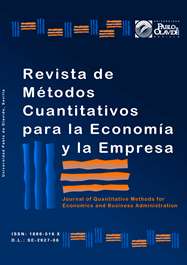The 5-Item Likert Scale and Percentage Scale Correspondence with Implications for the Use of Models with (Fuzzy) Linguistic Variables
DOI:
https://doi.org/10.46661/revmetodoscuanteconempresa.4010Keywords:
decision-making, evaluation, fuzzy linguistic variables, international study, Likert scaleAbstract
The aim of this paper is to examine how people perceive correspondence between the 5-item Likert scale and the percentage scale (the LS-PS correspondence thereinafter). Are all five items of the Likert scale equidistant? Do people use the same scale when evaluating different objects? Are men and women different? Are people from different countries / cultures different? The method of the study was a questionnaire with 661 participating respondents altogether from the Czech Republic, Ecuador, and France. The results indicate that the 5-item Likert scale is neither equidistant, nor symmetrical. Furthermore, there are (highly) statistically significant differences in the LS-PS correspondence with respect to location, age, or gender of respondents. The results can be used as an input for more precise decision-making modeling associated with (fuzzy) linguistic variables.
Downloads
References
Allen, E., & Seaman, C. (2007). Likert Scales and Data Analyses. Quality Progress, 40(7), 64-65.
Blaikie, N. (2003). Analyzing Quantitative Data. From Description to Explanation. Sage Publications, Thousand Oaks, 353. DOI: 10.4135/9781849208604.
Carrasco, R.A., Villar, P., Hornos, M.J., & Herrera-Viedma, E. (2012). A Linguistic Multi-Criteria Decision Making Model Applied to the Integration of Education Questionnaires. International Journal of Computational Intelligence Systems, 4(5), 946-959.
Casola, V., Preziosi, R., Rak, M., & Troiano, L.A. (2005). Reference Model for Security Level Evaluation: Policy and Fuzzy Techniques. Journal of Universal Computer Science, 11(1), 150-174. DOI: 10.3217/jucs-011-01-0150.
Clason, D.L., & Dormody, T.J. (1994). Analyzing data measured by individual likert-type items. Journal of Agricultural Education, 35(4), 31-35. DOI:10.5032/jae.1994.04031.
Creswell, J.W. (2008). Educational Research: Planning, Conducting and Evaluating Quantitative and Qualitative Research. New Jersey, United States: Pearson Education Inc.
Dawes, J. (2008). Do Data Characteristics Change According to the number of scale points used? An experiment using 5-point, 7-point and 10-point scales. International Journal of Market Research, 50(1), 61-77.
Edwards, A.L., & Kenney, K.C. (1946). A comparison of the Thurstone and Likert techniques of attitude scale construction. Journal of Applied Psychology, 30(1), 72-83. DOI: 10.1037/h0062418.
Hasson, D., & Arnetz, B.B. (2005). Validation and Findings Comparing VAS vs. Likert Scales for Psychosocial Measurements. International Electronic Journal of Health Education, 8, 178-192.
Hesketh, B., Prior, R., Gleitzman, M., & Hesketh, T. (1988). Practical Applications and Psychometric Evaluation of a Computerised Fuzzy Graphic Rating Scale. Advances in Psychology, 56, 425-454.
Holeček, P., & Talašová, J. (2010). FUZZME: A new software for multiple-criteria fuzzy evaluation. Acta Universitatis Matthiae Belii ser. Mathematics, 16, 35-51.
Joshi, A., Kale, S., Chandel, S., & Pal, D.K. (2015). Likert Scale: Explored and Explained. British Journal of Applied Science & Technology, 7(4), 396-403.
Likert, R. (1932). A Technique for the Measurement of Attitudes. Archives of Psychology, 140, 1-55.
Lima Jr., F.R, Carvalho, G.M.R., & Carpinetti, L.C.R. (2016). A methodology based on fuzzy inference and SCOR® model for supplier performance evaluation. Gest. Prod., São Carlos, 2016 23(3), 515-534. Available from http://www.scielo.br /scielo.php?script=sci_arttext&pid=S0104-530X2016000300515&lng=en&nrm=iso. Accessed on 11 Nov. 2018. DOI: 10.1590/0104-530x2625-15.
Lin, L., & Yeh, H. (2012). Linking Consumer Perception of Store Image Using FANP. iBusiness, 4(1), 18-28. DOI: 10.4236/ib.2012.41003.
Norman, G. (2010). Likert scales, levels of measurement and the “laws” of statistics. Advances in Health Science Education, 15(5), 625-632.
Prasad, B. (2016). Using Likert Type Data in Social Science Research. Confusion, Issues and Challenges. International Journal of Contemporary Applied Sciences, 3(2), 36-49.
Traylor, M. (1983). Ordinal and interval scaling. Journal of the Market Research Society, 25(4), 297-303.
Yan, H., Zeng, X., Bruniaux, P., Chen, Y., & Zhang, X. (2017). Development of a new knowledge-based fabric recommendation system by integrating the collaborative design process and multi-criteria decision support. Textil Research Journal, 88(23), 2682-2698. DOI: 10.1177/0040517517729383.
Willits, F.K., Theodori, G.L. & Luloff, A.E. (2016). Another Look at Likert Scales. Journal of Rural Social Sciences, 31(3), 126-139.
Downloads
Published
How to Cite
Issue
Section
License

This work is licensed under a Creative Commons Attribution-ShareAlike 4.0 International License.
Submission of manuscripts implies that the work described has not been published before (except in the form of an abstract or as part of thesis), that it is not under consideration for publication elsewhere and that, in case of acceptance, the authors agree to automatic transfer of the copyright to the Journal for its publication and dissemination. Authors retain the authors' right to use and share the article according to a personal or instutional use or scholarly sharing purposes; in addition, they retain patent, trademark and other intellectual property rights (including research data).
All the articles are published in the Journal under the Creative Commons license CC-BY-SA (Attribution-ShareAlike). It is allowed a commercial use of the work (always including the author attribution) and other derivative works, which must be released under the same license as the original work.
Up to Volume 21, this Journal has been licensing the articles under the Creative Commons license CC-BY-SA 3.0 ES. Starting from Volume 22, the Creative Commons license CC-BY-SA 4.0 is used.










